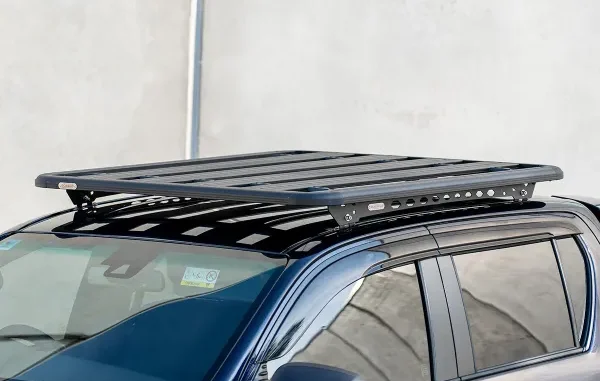

Imagine you’ve just packed up your Hilux for a weekend escapade—tent, recovery equipment, and surfboard—but now your tray is full, and the cabin is tight.
That’s when you see how much simpler all this would be with a heavy-duty roof rack.
Whether you’re heading for rugged terrain or carrying tools to the worksite, the appropriate roof rack makes your Hilux an entirely equipped adventure or work truck. From low-profile configurations that slice through wind noise to heavy-duty platforms that conquer the most unforgiving terrain, the ideal configuration is important.
But it’s not a matter of stuffing in more gear—it’s about stuffing in safely, smartly, and within your vehicle’s capabilities. By doing it correctly, you can maximize functionality without sacrificing performance or comfort.
Continue reading to learn how to select, fit, and tailor your Toyota Hilux’s roof rack for the next outing.
1. Choose the Right Rack for Your Needs

While selecting a roof rack for your Hilux, pick the one that is best for the usage of your vehicle.
If your usual excursions are with lighter payloads and aerodynamic cruising, a low-profile rack is best for you. Not only would you be preserving your fuel economy, but wind drag and noise would also be kept at a minimum.
On the other hand, if your Hilux is your work vehicle or off-road explorer, a heavy-duty platform-style rack becomes a necessity. That’s why choosing the right Toyota Hilux roof racks is more than just a style decision—it’s about matching your setup to the demands of your lifestyle.
So whether you’re cruising the city streets or the highways, the right rack will help keep your gear safe, your vehicle running smoothly, and your Hilux ready for anything. Make sure to assess your priorities.
With the right rack, you’re not just adding storage—you’re unlocking your vehicle’s full potential.
2. Check Weight Capacity and Fitment
Before mounting anything, it’s vital to understand your Hilux’s roof load capacity. Most are unaware that driving over the dynamic weight capacity of the roof, which is approximately 75 kilograms, can impact safety and car handling. Remember, this figure also includes the weight of the rack.
For instance, if your rack weighs 24 kilograms, you then only have about 50 kilograms for your luggage. This becomes increasingly valuable when you consider other equipment, such as roof tents, fuel tanks, or tools.
You’ll also need to ensure the rack is compatible with your vehicle’s model. A proper fit equates to bolted-on safety and no margin for error, especially when driving on bad roads or at freeway speeds. Carefully adhering to these specifications avoids overloading, maintains the integrity of your vehicle, and allows for all travel to be conducted with safety.
3. Maximize Gear Hauling Flexibility
Once your rack is installed, your Hilux becomes more than just a vehicle—it becomes a mobile workstation or expedition base, depending on your goals. You’re able to attach a wide variety of accessories in mere minutes, thanks to its modular platform design.
From T-slot tracks to custom-made brackets, you can fit rooftop tents, solar panels, gas bottle holders, jerry cans, and even bike or kayak holders within minutes. This is the sort of flexibility that is a game-changer when transitioning from work weeks to weekend getaways.
Additionally, since the platform is wide and level, it’s easy to load oversized items, such as timber, ladders, or picnic tables, without the inconvenience of fiddly fitment. Each bracket and slot is made to fit easily, with trouble-free mounting.
Rather than attempting to cram gear into the cabin or tray, your rack provides you with elevated, organized space.
4. Prioritize Off-Road Durability and Noise Reduction
Your Hilux is built to tackle tough terrain—and your roof rack should be no different. Off-road durability is non-negotiable if you’re venturing beyond the tarmac.
A quality rack constructed from powder-coated aluminum and steel not only resists rust but also handles vibrations and shocks from rough trails. Over time, that means fewer rattles and a longer lifespan.
But durability isn’t the only factor; noise control matters, too. Especially during long highway drives, wind noise from bulky roof setups can be distracting and fatiguing.
That’s why choosing a rack with an aerodynamic profile or built-in wind deflectors is crucial. These features help streamline airflow, cutting down on that constant whooshing sound.
By investing in a rack that’s both rugged and quiet, you’re setting yourself up for smoother, more enjoyable drives—whether you’re adventuring through wild roads or cruising at 110 on open roads. It’s about performance without compromise.
5. Follow Smart Installation Tips and Considerations
When installing a roof rack on your Hilux, precision is key. Start by deciding whether to mount the rack on the car or a canopy. Mounting it on the car is generally the most secure and structurally sound option since the car’s roof is reinforced to handle weight.
Canopy mounting is possible, but it often requires additional bracing or reinforced materials, especially if you plan to carry heavier items. You also need to consider height clearance—adding a rack can raise your vehicle’s profile by 60–70 mm or more. This affects parking in garages or underground lots.
Measure carefully before installing, particularly if you’re adding a rooftop tent or bulky gear. Keep tools and instructions on hand during installation and double-check bolt torque to prevent movement.
A well-installed rack isn’t just safer—it functions better, lasts longer, and gives you peace of mind when you’re fully loaded and heading off-road or down the highway.
Conclusion
With the right heavy-duty roof rack, your Hilux becomes more than just transport—it’s a tool, a base, and an adventure companion. You gain storage, flexibility, and confidence on every journey.
Whether you’re heading to the job site or deep into the forest, smart rack choices make all the difference. Equip your Hilux properly, and the road ahead is yours to own—wherever it leads.

Leave a Reply